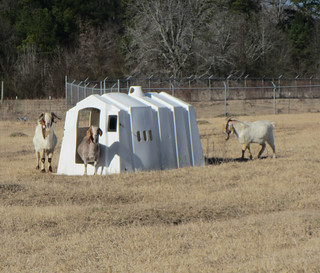Animals get hot, too; need relief from heat
August 4, 2014
(428 words)
Shade structures do not need to be expensive or complicated. This calf hutch provides adequate shade for adult goats. (UAPB image)
PINE BLUFF, Ark. – Hot weather affects animals, too. “I am always amazed by the number of people who ask ‘Do animals really need shade?’” says Dr. David Fernandez, Cooperative Extension Program livestock specialist at the University of Arkansas at Pine Bluff.
Providing shade and cool water can reduce productivity losses and make animals more comfortable, he says. As the days get hotter, animals spend less time grazing and drink more water, says Fernandez.
Animals gain heat two ways – conduction and radiation. Conduction is heat transferred from an object to an animal when they touch. Animals lying on hot ground are warmed as the hot ground transfers heat to their bodies.
Radiation from the sun heats animals’ bodies by increasing the energy in the molecules of their bodies when it strikes them and is absorbed. Darker colored animals absorb more heat than lighter colored animals, says Fernandez. Some animals have light colored hair but dark colored skin, so they can become warm much faster than you think, he says.
Animals generate heat as they metabolize feed and move. Between internal heat generation and external warming on hot days, animals can overheat. Overheating causes them to go off feed, increases heart and respiration rates, impairs weight gain and causes reproductive failure especially in males.
Heat stress also suppresses the immune system resulting in outbreaks of diseases such as pneumonia during especially hot weather. Severely affected animals can become weak and unable to stand. Extremely elevated temperatures of more than 107 degrees Fahrenheit, can result in death.
Shade helps animals keep cool. Animals keep cool in a variety of ways. They reduce their activity and seek shade where they often can be found lying down. They may pant, or in the cases of horses or Brahman cattle, they sweat.
Drinking cool water also helps. The water should be as cool you as you can manage, says Fernandez. Simply erecting a shade over the water trough or tank makes the water much cooler.
Sheep with an inch or so of wool are cooler than freshly shorn sheep and less likely to get a sunburn. If growers must shear their sheep, Fernandez advises doing so in the spring so the wool has a chance to grow a little.
Avoid working animals in the hottest part of the day. Increased activity can overheat their already hot bodies and cause heat stress. Most farm animals are well adapted to both the heat and cold of Arkansas. They just need shade and cool water to stay well and comfortable, says Fernandez.
For more information, contact Fernandez at (870) 575-7214 or fernandezd@uapb.edu.
The University of Arkansas at Pine Bluff School of Agriculture, Fisheries and Human Sciences offers all its programs and services (including employment) without regard to race, color, sex, national origin, religion, age, disability, marital or veteran status, genetic information, sexual preference, pregnancy or any other legally protected status, and is an equal opportunity institution.
Pursuant to 7 CFR § 15.3, the University of Arkansas System Division of Agriculture offers all its Extension and Research programs and services (including employment) without regard to race, color, sex, national origin, religion, age, disability, marital or veteran status, genetic information, sexual preference, pregnancy or any other legally protected status, and is an equal opportunity institution.
By Carol Sanders, writer/editor
UAPB School of Agriculture, Fisheries and Human Sciences
(870) 575-7238
sandersc@uapb.edu
Related Links
